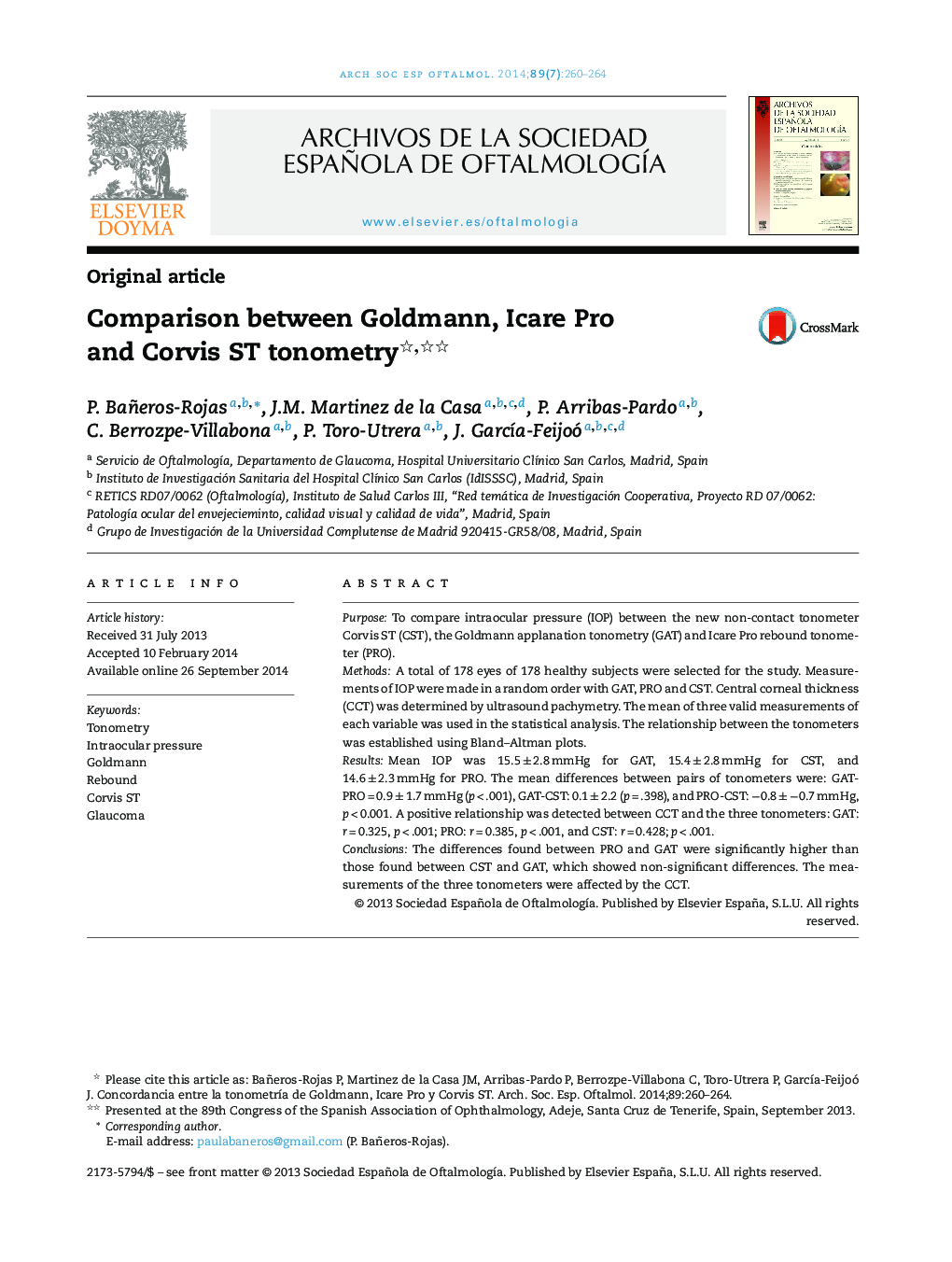| Article ID | Journal | Published Year | Pages | File Type |
|---|---|---|---|---|
| 4008144 | Archivos de la Sociedad Española de Oftalmología (English Edition) | 2014 | 5 Pages |
PurposeTo compare intraocular pressure (IOP) between the new non-contact tonometer Corvis ST (CST), the Goldmann applanation tonometry (GAT) and Icare Pro rebound tonometer (PRO).MethodsA total of 178 eyes of 178 healthy subjects were selected for the study. Measurements of IOP were made in a random order with GAT, PRO and CST. Central corneal thickness (CCT) was determined by ultrasound pachymetry. The mean of three valid measurements of each variable was used in the statistical analysis. The relationship between the tonometers was established using Bland–Altman plots.ResultsMean IOP was 15.5 ± 2.8 mmHg for GAT, 15.4 ± 2.8 mmHg for CST, and 14.6 ± 2.3 mmHg for PRO. The mean differences between pairs of tonometers were: GAT-PRO = 0.9 ± 1.7 mmHg (p < .001), GAT-CST: 0.1 ± 2.2 (p = .398), and PRO-CST: −0.8 ± −0.7 mmHg, p < 0.001. A positive relationship was detected between CCT and the three tonometers: GAT: r = 0.325, p < .001; PRO: r = 0.385, p < .001, and CST: r = 0.428; p < .001.ConclusionsThe differences found between PRO and GAT were significantly higher than those found between CST and GAT, which showed non-significant differences. The measurements of the three tonometers were affected by the CCT.
ResumenObjetivoComparar los valores de presión intraocular (PIO) del nuevo tonómetro de no contacto Corvis ST (CST) con la tonometría de aplanación de Goldmann (GAT) y la tonometría de rebote Icare Pro (PRO).Material y métodosSe seleccionaron 178 ojos de 178 voluntarios sanos a los que se les midió la PIO de manera aleatorizada con CST, PRO y GAT. Se midió el espesor corneal central (GCC) con paquimetría ultrasónica. Para cada variable, se tomaron 3 medidas y la media de las 3 fue introducida en el análisis estadístico. La concordancia entre los tonómetros se determinó mediante las gráficas de Bland-Altmann.ResultadosLa PIO medias obtenidas con los 3 tonómetros fueron de 15,5 ± 2,8 mmHg para GAT, 14,6 ± 2,3 mmHg para PRO y 15,4 ± 2,8 mmHg para CST. La diferencia media entre pares de tonómetros fue: GAT-PRO = 0,9 ± 1,7 mmHg (p < 0,001); GAT-CST: 0,1 ± 2,2 (p = 0,398) y PRO-CST: −0,8 ± −0,7 mmHg, p < 0,001. En los 3 casos se encontró una correlación significativa con el GCC: GAT: r = 0,325, p < 0,001; PRO: r = 0,385, p < 0,001 y CST: r = 0,428; p < 0,001.ConclusionesLas diferencias encontradas entre el PRO y el GAT son significativamente mayores que entre el CST y el GAT, sin diferencias significativas entre las medidas de estos 2. Las medidas de los 3 tonómetros se ven afectadas por el GCC.
